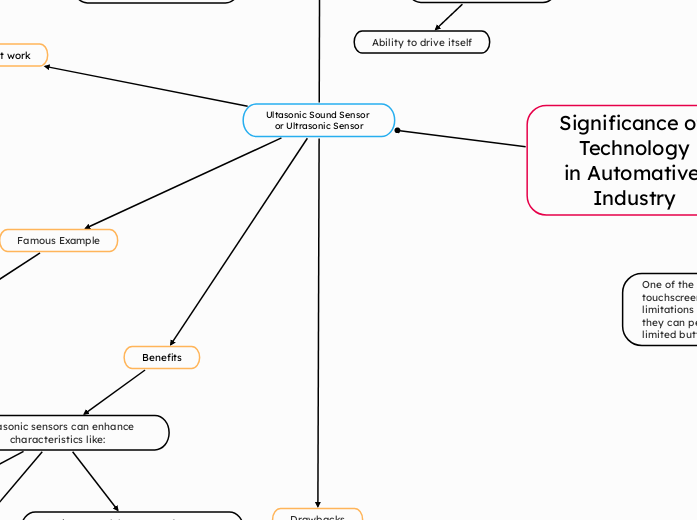Significance of Technology
in Automative Industry
Ultasonic Sound Sensor
or Ultrasonic Sensor
The restricted detection range of ultrasonic sensors is problematic because, particularly at higher speeds, it can make it more difficult for a vehicle to identify obstacles in time to take appropriate action.
Famous Example
A segment of Volvo vehicles
are being developed for
their Drive Me autonomous
project.
The speed and movement are affected by these situations and the sensors having the responsibility to adjust these functions.
These vehicles are equipped with twelve ultrasonic sensors throughout each vehicle.
The sensors identify items, pedestrians, and environmental factors in various contexts
Manages car movement and speed
Ultrasonic sensors can enhance characteristics like:
Cruise control: keeps a safe distance from other automobiles
Blind-spot detection alerts drivers to cars that are in their blind areas.
Automated brakes for emergencies: halts the vehicle to avoid crashes
How does it work
Vehicles equipped with
ultrasonic sensors emit
soundwaves to the object
and then analyze the refected
waves. This can make the vehicle:
Avoid collisions
Identify objects
Measure distances
Sensing and Respondng
to their surroundings
Innovative Features
(for specifc vehicles)
Ability to drive itself
Parking Assistance
Crucial to the developing automomotive industry
Buttons
Drawbacks
A significant factor is cost. It's more economical for automakers to program different screen layouts for various trim levels of the same car, rather than creating entirely different physical dashboard layouts (the control panel area where drivers interact with buttons, knobs, and switches) for each trim level.
Today's vehicles are more complex than ever, and we ask them to perform more tasks. Some things we want them to do aren't easily done with physical buttons and switches.
One of the good things about touchscreens is the lack of limitations to how many functions they can perform, compared to the limited buttons in a car.
Benefits
Since the buttons are always at a specific location in the car, drivers can quickly memorize where their controls are with muscle memory. This can allow drivers to turn up the A/C without necessarily looking at the A/C controls. Many drivers would have to take their eyes off the road with a touchscreen to fiddle with it.
Buttons are also easy to clean, which is another valuable benefit compared to a big touchscreen. Perhaps the most important advantage of physical controls is that they’re less distracting, and thus, they can be safer to use.
Buttons are cheap, and people usually don’t mind using their car’s buttons when their fingers are greasy.
Purpose
These buttons improve the accessibility, security, and experience of the automobile's user.
Modern cars come equipped with push buttons that do things like getting the engine running and modifying the climate control system, and more.









